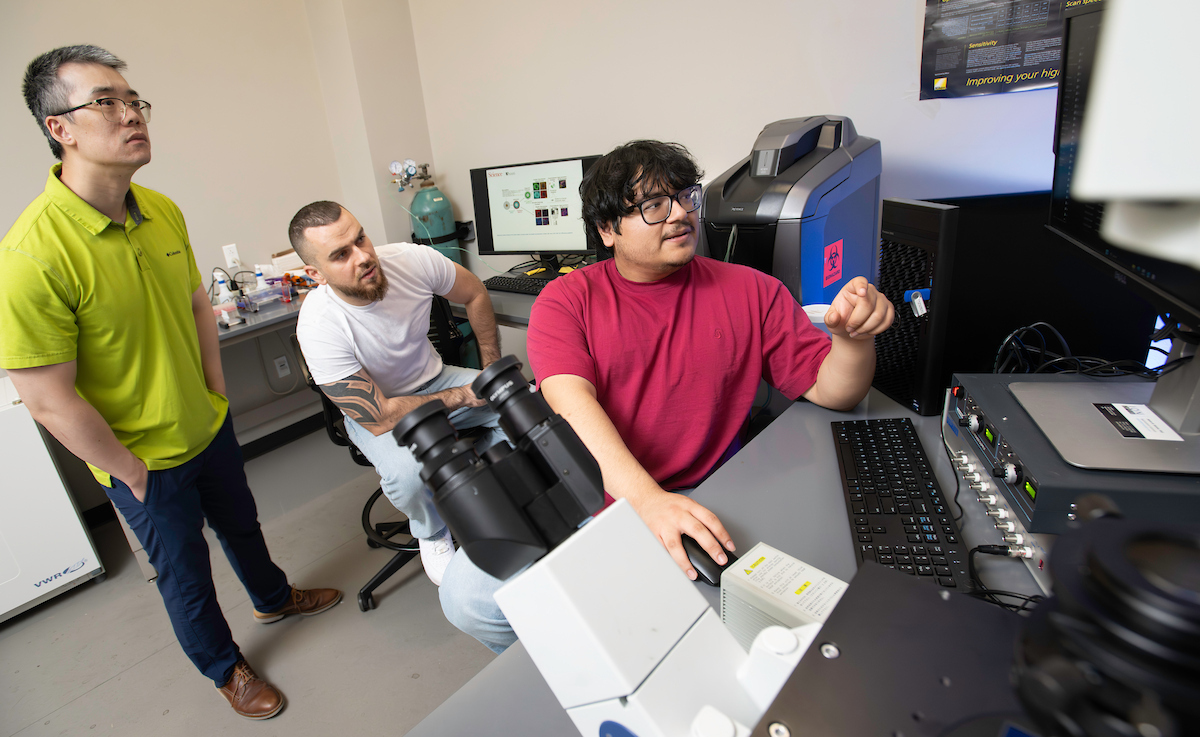
DENTON (UNT), Texas — Inside the University of North Texas’ Discovery Park research campus, researchers are making groundbreaking discoveries that can lead to safer and more accurate heart treatment testing and open the door to more collaboration between engineers and biomedical researchers.
Adam Yang, assistant professor in the College of Engineering’s biomedical engineering department, and his team are creating tiny lab-grown artificial organs called organoids. What makes these organoids special is that they’re vascularized, meaning they feature a blood vessel network capable of mimicking a real network.
“Without blood vessels, we could not survive, similar to the organoids,” Yang said. “Blood vessels are an essential part of the human heart and liver, but were generally lacking in organoid systems before this project. Now we can make organoids more realistic.”
The project was a long and arduous one. Yang began the research in 2017 while working as a post-doctoral researcher at Stanford University. He then joined UNT in 2020 and continued working on the relevant projects in his independent lab.
“It was exciting when I first started it because it was a new idea, especially adding the vessel network,” Yang said. “But it was also challenging because people would ask why we needed to study this. We had to convince them it was important even if it would take years.”
Yang said the support from UNT, Stanford, the American Heart Association, the National Institutes of Health (NIH), and other federal grants was essential. One critical source of support was the NIH G-RISE program, which allows doctoral candidates such as Angello Gomez to work on the project. The program supports people from underrepresented backgrounds earning their doctoral degrees in a biomedical field.
“There aren’t many people of our background in the field, so I’m really grateful for UNT supporting us,” Gomez said.
Gomez joined the project about five years in and was responsible for vascularized cardiac organoid differentiation, data analysis, and validating the research by showing the organoids were reproducible.
“It really is groundbreaking because no other work before has built a fully vascularized network in the heart and liver organoids before,” Gomez said. “This was a big issue because you need this network to supply nutrients to the core of the organoids. We couldn’t grow them to a larger size because there’d be dead cells would form in the core.”
Currently, the organoids mimic an embryonic heart about six and a half weeks after gestation and are about 2 millimeters in diameter. Yang and Gomez hope the reproducible method will create a bridge between engineers and cardiologists, and biomedical scientists.
“These organoids can become an alternative to animal models,” Yang said. “We know the U.S. Food and Drug Administration’s Modernization Act 2.0/3.0 would like to move towards using organoids for drug response and genetic disease testing as an alternative when possible.”
Yang stressed that the team isn’t looking to replace animal models but to be equivalent with them as alternatives at this moment.
“There was no previous publication to guide us on this project,” he said. “We got our guidance from previous animal and human studies in the biology field. It’s important we all work together.”
The project has now been published in Science, one of the world’s top academic journals, and Yang says they’re beginning to see more interest in their research in organoids. His team has already moved on to the next phase of research, making the organoids even more like a human heart.
One of those improvements involves mimicking blood flow inside the heart, which is what Gomez is focusing on as part of his dissertation.
“These organoids can’t produce blood cells, so mimicking blood flow means I’m subjecting the networks to the same kind of stress they’d face if fluid were moving through them and pushing against the tunnel walls,” he said.
Gomez, who earned his bachelor’s and master’s degrees in biomedical engineering at UNT, has a personal reason motivating him in his studies.
“I had a cousin who had congenital heart disease, and he didn’t make it. It’s sad because he was in his teens,” Gomez said. “I want to use my skills and knowledge and contribute to lowering cardiovascular disease.”
Gomez studies how the stress on the blood vessels could affect how the heart is formed inside an embryo. If he can reliably form cardiac organoids with a congenital heart disease, that can provide better insight into how it forms in embryos and then how to treat it with drugs or gene therapy.
“After that, we can test drugs on the organoids without worrying about the effects on a living organism,” Gomez said. “There’s so many applications for these vascularized organoids, and I’m glad I can do my part.”